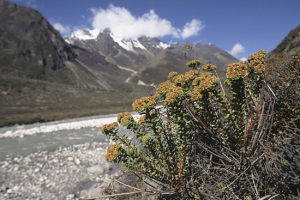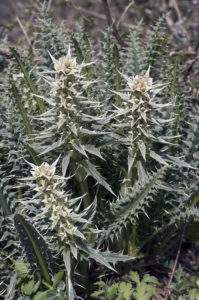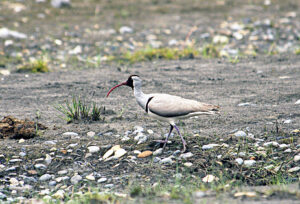Kaj Halberg - writer & photographer
Travels ‐ Landscapes ‐ Wildlife ‐ People
Around sacred lakes of Shiva
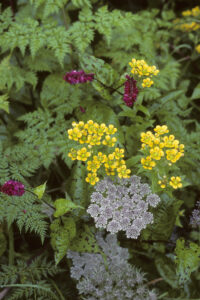
To perform this stupendous task, the gods and the asuras uprooted the mountain Mandara, placing it upside down in the ocean, and coiling the giant, many-headed naga (serpent) Vasuki around it. By pulling alternately at each end of Vasuki, the mountain would act as a gigantic churn, thus bringing the amrita to the surface. However, when the churning was started, the mountain began sinking into the ocean floor, so Vishnu assumed the shape of a gigantic avatar (incarnation), named Kurma, half man, half turtle, and dived to the bottom of the sea, where he placed Mandara on his back, thus supporting the churning.
Finally, the jar with amrita surfaced, whereupon a fierce battle between the gods and the asuras ensued, the latter grabbing the jar and running away with it. Again, the gods appealed to Vishnu, who assumed the form of a new avatar, Mohini, a beautiful goddess, who seduced the asuras and managed to get hold of the jar of amrita, thus preventing evil from becoming eternal, and preserving the good.
The churning, however, was extremely painful to Vasuki, who began spitting out large quantities of venom. This was noticed by the supreme god Shiva, who swallowed the poison to save the other gods. This made him suffer terribly from fever and thirst, and to relieve his sufferings, he went into the Himalaya in search of water, but found none. He now cast his trisul (trident) on the rocks, whereupon gigantic springs emerged, creating 54 lakes. Shiva lay down to quench his thirst from one of the lakes, which was later named Gosain Kund. (Gosain is another name for Shiva.)
Below the surface of this lake is an oval rock, which devout Hindus regard as Shiva, resting on the serpent Vasuki. On this rock is a smaller stone, which is regarded as a Shiva-lingam (a phallus-shaped symbol of fertility). The river, which drains the lake, is called Trisuli Khola, named after Shiva’s trident.
Shiva, Vishnu, and other Hindu gods are presented in depth on the page Religion: Hinduism.
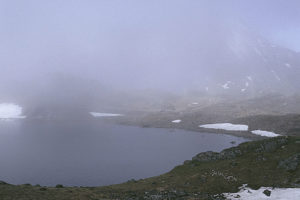
This park is home to several threatened animals, including snow leopard (Panthera uncia), red panda (Ailurus fulgens), and a gorgeous pheasant, the satyr tragopan (Tragopan satyra).
The major part of the area is only accessible on foot. A road has been constructed to the villages of Dhunche and Shyabrubesi, situated at the western outskirts of the park. From here, you must hike for two days to get to the Gosain Kund area, and for three or four days to reach the Upper Langtang Valley, near the Tibetan border. From the village of Sundarijal, in the Kathmandu Valley, a four-day-hike will take you to Gosain Kund, via Tharepati.
In most settlements along the way, you encounter small hotels, where you can eat and sleep. However, the area around a high-altitude pass, the Ganja La (5106 m), is uninhabited. If you camp in the park, you must bring a stove and kerosene, as usage of firewood is prohibited.
The major part of the plant species mentioned below are described on the pages Plants: Himalayan flora 1, 2, and 3.
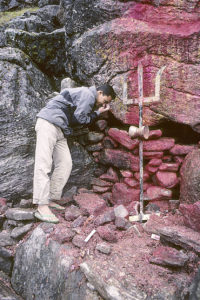
At higher altitudes, the broad-leaved forest gives way to conifers like silver fir, hemlock, and blue pine. Clearings in the forest, called kharka, are utilized as grazing grounds, and for harvesting hay. Vegetation in these clearings is lush, comprising a creeping, cloudberry-like bramble, Rubus nepalensis, which has delicious, slightly sour, red fruits, a white umbellifer, Selinum wallichianum, various species of saxifrage (Saxifraga), a red lousewort, Pedicularis megalantha, a teasel, Dipsacus inermis, and others.
From Tharepati, situated on a ridge at an altitude of c. 3,600 m, you have a gorgeous view towards mountains in Tibet, dominated by Shishapangma (8013 m). Further on, the trail becomes stony and difficult, leading through a beautiful and intact forest of maples and oaks, in which countless streams cross the path. Various herbs grow on the forest floor, including a beautiful composite, Cremanthodium nepalense, a blue-flowered meadow-rue, Thalictrum reniforme, and several species of balsam (Impatiens).
This area is home to three gorgeous species of pheasant. Besides the above-mentioned satyr tragopan, you may encounter monal pheasant (Lophophorus impejanus), also called danfe, the national bird of Nepal. Locally, this species is called ’the bird of nine colours’, in allusion to the brilliant plumage of the cock. The third species is the smaller blood pheasant (Ithaginis cruentus), whose name refers to the red, tear-shaped spots on the cock’s breast. Pictures, depicting the latter two species, are shown on the page Animals – Birds: Birds in the Himalaya.
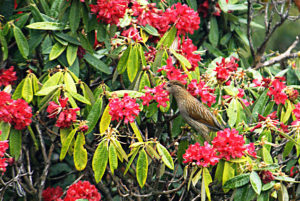
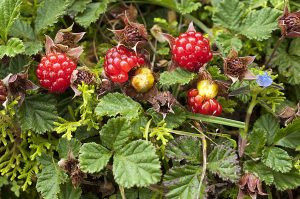

The trail follows the shore of several sacred lakes, including Surya Kund, Ganesh Kund, and Bhairab Kund, leading to a group of hotels near the larger Gosain Kund, situated at an altitude of 4,400 m. This area has an interesting alpine flora, comprising Cyananthus lobatus and Codonopsis thalictrifolia, both of the bellflower family, a cinquefoil, Potentilla peduncularis, the blue-flowered Kashmir corydalis (Corydalis cashmeriana), and others.
From Gosain Kund, the trail heads further west, passing two other lakes, Nag Kund and Saraswati Kund, then following a ridge down through dense thickets of Rhododendron anthopogon, in Nepali called sun pathi. Dried flowers of this dwarf shrub are utilized as tea, and its branches are burned as incense in temples and on house altars. The northern side of the ridge is covered in a splendid forest of silver firs.
From a Buddhist monastery, Sing Gompa, two trails lead down, one heading south towards Dhunche, the other west towards the village of Thulo Shyabru, from where another trail leads down to the subtropical part of the Langtang Valley.
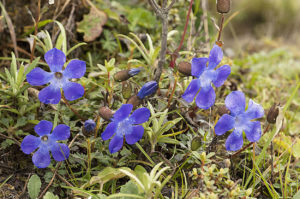

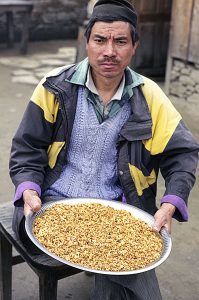
Here and there, the forest floor is covered in dense growths of dwarf bamboo, and clearings are often taken over by two beautiful shrubs, Pieris formosa and Gaultheria fragrantissima, both belonging to the heath family. Two lovely species of ground-living orchids, Calanthe tricarinata and C. plantaginea, are often encountered.
The village of Thulo Shyabru has a beautiful location, situated along a ridge at an altitude of c. 2,200 m, surrounded by terraced fields, on which wheat, buckwheat, and potatoes are cultivated. In the forest below this village, near the Langtang Khola River, inflorescences of Himalayan dogwood (Cornus capitata) are very conspicuous in spring, displaying showy yellowish bracts, which surround the small, yellowish-green flowers.
Lush forest covers the river banks, consisting mainly of two oak species, Quercus lanata and Cyclobalanopsis lamellosa. In summer, bird life is abundant here, and a huge chorus of cicadas make a racket. A monkey with whitish fur and a black face, the pale-armed langur (Semnopithecus schistaceus), is often observed feeding in the trees, and with luck you may also see the beautiful yellow-throated marten (Martes flavigula).
This langur, and many other monkeys, are presented on the page Animals – Mammals: Monkeys and apes.
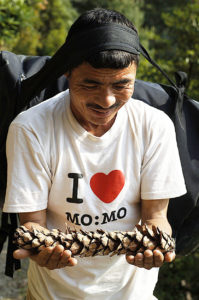
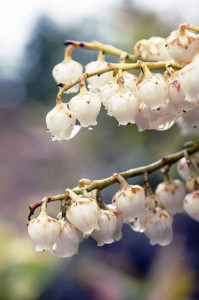
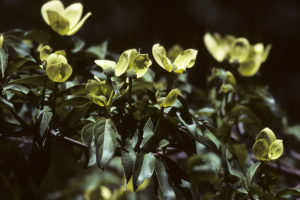
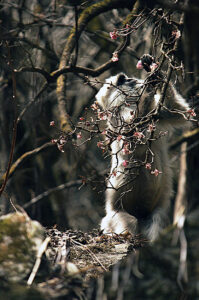
As a sharp contrast to the barren north side, the south side of the river is covered in lush forests. Landslides are frequent in this area, and in the course of a few years, these landslides are often invaded by Nepalese alder (Alnus nepalensis) – a typical pioneer tree, which, over time, forms light forests.
At an altitude of c. 2,500 m, the broad-leaved forest gives way to a mixed forest of spiny-leaved oak (Quercus semecarpifolia), the leaves of which resemble those of European holly (Ilex aquifolium), and various conifers, such as silver fir, hemlock, and Himalayan spruce (Picea smithiana), the latter having its easternmost populations in this area. Hemlock is easily identified by its cones, which are no bigger than blackbird eggs. In May and June, a profusion of epiphytic orchids, Pleione hookeriana, are blooming on the moss-covered conifers in this zone.
A number of Arisaema species, of the arum family (Araceae), are encountered on the forest floor. The inflorescence of these plants consists of a large, leaf-like spathe, encircling a club-like spadix, on which numerous small flowers are clustered. In some rather bizarre species, spathe and/or spadix ends in a long thread, sometimes up to 1 m long. The spathe of several species, especially A. nepenthoides, resembles a cobra with its hood spread out. In autumn, a cob-like cluster of red berries is formed around the spadix. The latter two properties combined have given these plants their Nepali name, sarpa ko makai, meaning ’snake maize’. This genus comprises altogether 17 species in the Himalaya.
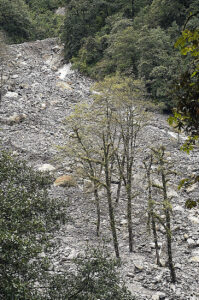
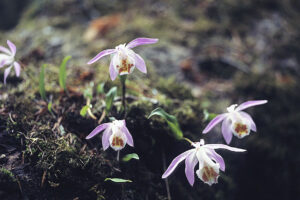

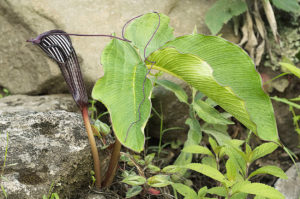
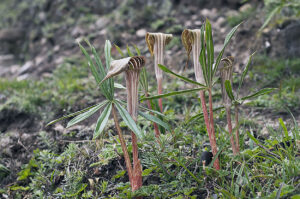
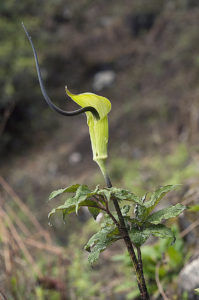
Many herbs grow among the bushes, including a pinkish-blue primrose, Primula denticulata, a beautiful yellowish poppy, Meconopsis dhwoji, the red-flowered Chinese ladies’ tresses (Spiranthes sinensis), and a wonderful blue larkspur, Delphinium kamaonense.
Most inhabitants of Langtang Village are Buddhists, which is obvious from the many fluttering prayer flags on the houses, and a chorten, the Tibetan version of a Buddhist stupa – a domed building, which often contains religious relics, for example bones or ashes from a holy man. Along the trails, many mani walls (flat stone slabs with carved Buddhist mantras) have been constructed. Over time, these mani stones are often covered in colourful lichens. – Chortens, mani-stones and other Buddhist aspects are described on the page Religion: Buddhism.
On the rocky slopes along the valley, you may spot small flocks of Himalayan tahr (Hemitragus jemlahicus), a species of wild goat with short horns and a reddish-brown coat. On the chest, the buck has a flowing, light-brown mane.
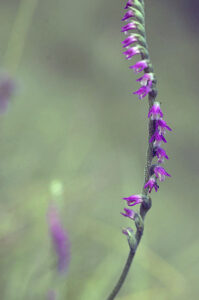


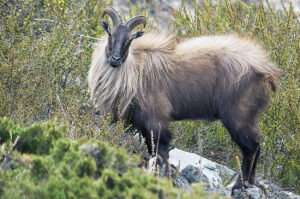
A number of hotels are clustered around Kyanjin Gompa, a Tibetan Buddhist monastery situated at an altitude of c. 3,900 m. The mountain slopes in this area are covered in forests of Himalayan birch (Betula utilis), mixed with the rare Nepalese larch (Larix himalaica). Dense shrubs of Rhododendron campanulatum cover the forest floor.
In these forests lives the rare alpine musk deer (Moschus chrysogaster). This little, deer-like animal has no antlers, the male instead having large canines in the upper jaw, utilized when fighting with other males for a territory. On the lower belly he has a gland, excreting musk, with which he marks his territory. The smell from the gland will also lure females to him. In India and China, the pheromone from this musk is much utilized as fragrance in perfume, and it is also widely used as an aphrodisiac. In many places, the musk deer is threatened by poaching. Pictures depicting alpine musk deer are shown on the page Animals – Mammals: Mammals in the Himalaya.
Between June and September, the meadows along the river in the Upper Langtang Valley, near the Tibetan border, display a profusion of flowers, including several species of cinquefoil and saxifrage, a sulphur-yellow primrose, Primula strumosa, and a violet pea flower, Tibetia himalaica (formerly Gueldenstaedtia himalaica).
You may also encounter a prickly, thistle-like plant, Morina polyphylla. Formerly, morinas were placed in a separate family, Morinaceae, but recent genetic research has revealed that they belong to the honeysuckle family (Caprifoliaceae). Four species occur in the Himalaya, all having stiff hairs or spines as a means of defence against grazing animals. The genus was named in honour of French physician, botanist, and meteorologist Louis Morin de Saint-Victor (1635-1715).
The Langtang Valley is a stronghold of a large, noisy wader, the ibisbill (Ibidorhyncha struthersii), which only breeds in Central Asian mountains. Its nest is placed among pebbles in a river bed, or in glacial moraine.

